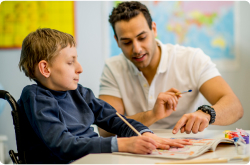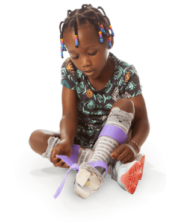Understanding cerebral palsy and ADHD
Cerebral palsy and ADHD are conditions that can impact a child’s daily life in different but significant ways.
Cerebral palsy (CP) primarily affects motor skills, causing difficulties with movement, coordination, and posture. While ADHD (attention-deficit/hyperactivity disorder) impacts behavior, attention, and impulsivity.
Nearly 20% of children with CP will also have ADHD, which can make managing both conditions more complex.
When cerebral palsy and ADHD occur together, children need specialized treatment plans to address both their physical and behavioral needs. Early diagnosis and intervention are key to helping children thrive.
Caring for a child with coexisting cerebral palsy and ADHD can feel overwhelming, especially with ongoing therapies, medical care, and special equipment often needed.
If medical negligence during childbirth contributed to your child’s cerebral palsy, financial support may be available to help cover the costs of top-quality care.
Cerebral Palsy Guide has partnered with a network of skilled CP lawyers who may be able to help your family.
Find out if we can connect you with a top cerebral palsy lawyer near you — get a free case review now.
What are cerebral palsy and ADHD?
Cerebral palsy and ADHD are two distinct conditions that can co-exist in children, adolescents, and adults. Understanding how each affects your child’s development can help guide treatment and care.
Learn more about each condition below.
Cerebral palsy overview
Cerebral palsy is a neurological disorder that primarily affects motor function and muscle control due to damage during brain development.
- Affects movement, coordination, and balance
- Caused by complications during or shortly after birth
- May result from medical malpractice during childbirth
- Typically requires ongoing therapies to manage
Cerebral palsy is a lifelong condition, but with the right support, children can lead full lives.
ADHD overview
Attention-deficit/hyperactivity disorder is a neurodevelopmental disorder affecting the brain's ability to regulate attention and behavior. ADHD impacts the ability to focus, control impulses, and stay still.
- Common symptoms are inattention, hyperactivity, and impulsivity
- May affect academic performance and social interactions
- Requires personalized treatment, like therapy or medication
Understanding the impact of coexisting ADHD and cerebral palsy is essential for creating a well-rounded care plan for your child.
Can you develop ADHD and cerebral palsy?
Yes, children with cerebral palsy can also have a diagnosis of ADHD. While ADHD is often diagnosed in early childhood, its symptoms may not be immediately apparent, especially in children with neurological conditions like CP.
Parents and caregivers may focus more on the motor impairments caused by cerebral palsy, which can overshadow the signs of ADHD, like trouble focusing or hyperactivity.
For children with CP, these ADHD symptoms might go unnoticed for longer since physical and mobility limitations take priority in their care.
However, as a child grows, behavioral and attention-related issues may become more noticeable.
If you suspect your child may have ADHD and cerebral palsy, a thorough evaluation by medical professionals can help identify both conditions and ensure proper treatment.
Co-existing conditions: How cerebral palsy and ADHD overlap
 Children with cerebral palsy and ADHD can experience a range of overlapping challenges. When cerebral palsy conditions co-exist, the symptoms of one can worsen the difficulties caused by the other.
Children with cerebral palsy and ADHD can experience a range of overlapping challenges. When cerebral palsy conditions co-exist, the symptoms of one can worsen the difficulties caused by the other.
For example, children with cerebral palsy often face physical challenges completing everyday tasks, while ADHD may add complications with staying focused and controlling behavior.
This can make it harder for them to succeed in school or social settings, as the double impact on motor skills and attention can harm their learning and development.
Cerebral palsy and ADHD may also lead to behavioral challenges, such as impulsivity or difficulty following instructions, which can further complicate treatment and therapy.
Managing these co-existing conditions often requires a tailored approach, with early intervention and specialized care to help children reach their full potential.
ADHD symptoms in children with cerebral palsy
Children with cerebral palsy and ADHD often display classic ADHD symptoms like inattention, hyperactivity, and impulsivity. However, the motor issues associated with CP symptoms can make these symptoms harder to notice.
For example, difficulty sitting still might be attributed to discomfort from cerebral palsy rather than hyperactivity from ADHD.
- Difficulty focusing
- Easily distracted
- Forgetfulness in daily tasks
- Frequently losing important items
- Impulsive actions
- Restlessness or trouble sitting still
- Trouble completing tasks
Attention-deficit/hyperactivity disorder can worsen learning difficulties in children with cerebral palsy and ADHD. Challenges with focus may impact their ability to follow instructions and stay on task.
This can make school and therapy sessions harder, especially when both conditions interfere with academic and motor skill development.
Managing these overlapping conditions requires a combination of therapies designed to address both physical and behavioral challenges.
Diagnosis for children with cerebral palsy and ADHD
Diagnosing cerebral palsy and ADHD in children can be more complex than diagnosing ADHD in the general population.
This is because the symptoms of cerebral palsy, like movement difficulties, can sometimes mask or overlap with ADHD symptoms like hyperactivity or impulsivity.
Doctors often use specialized tests to assess attention, focus, and behavior in children with cerebral palsy and ADHD, ensuring that both conditions are properly identified.
- Developmental screenings to track milestones and assess behavior
- Input from parents, caregivers, and teachers about the child’s daily functioning
- Specialized assessments for ADHD, including questionnaires and behavior evaluations
Because ADHD symptoms can be subtle in children with cerebral palsy, it may take longer for a clear diagnosis. It’s essential to work with a health care team that understands both conditions.
While ADHD cannot be cured, it can be managed effectively with treatments like medication, therapy, and individualized education plans (IEPs). This can help ensure children with cerebral palsy and ADHD thrive in daily life.
What causes ADHD?
ADHD is a complex condition with no single known cause. Current research suggests that a combination of genetic, environmental, and neurological factors plays a role in its development.
- Genetics: Children with close relatives who have ADHD are more likely to develop the disorder, according to previous studies
- Prenatal exposure: Exposure to alcohol, tobacco, or drugs during pregnancy increases the risk of ADHD and other abnormalities
- Brain injury: Trauma, particularly to the frontal lobe, may lead to attention and impulse control issues and challenges with executive functioning
- Environmental toxins: Lead and other environmental toxins can hinder neuropsychological development and contribute to ADHD
Like ADHD, cerebral palsy also has multiple causes, including medical errors that occur before, during, or shortly after childbirth.
If your child has cerebral palsy that you suspect should have been prevented, you may be able to access financial assistance.
Connect with one of our registered nurses for free. They are here to listen to your story and answer your questions.
Types of ADHD
There are 3 main types of ADHD, each with its own unique set of symptoms. Knowing the type of ADHD your child has can help customize a treatment plan, especially when dealing with cerebral palsy and ADHD.
Learn about ADHD types below.
1. ADHD, inattentive and distractable
Children with inattentive ADHD often seem lost in thought or distracted, leading to challenges in completing everyday tasks.
- Difficulty focusing: Children may struggle to pay attention to details
- Forgetfulness: Common tasks or important items are easily forgotten
- Trouble completing tasks: Long or complex tasks may seem overwhelming, leading to incomplete work
Understanding inattentive ADHD is important when creating care plans for children with cerebral palsy and ADHD. Ensuring both conditions are managed is key to improving quality of life.
2. ADHD, impulsive/hyperactive
Children with hyperactive-impulsive ADHD are always on the go. They may fidget, interrupt conversations, or have trouble waiting their turn.
- Excessive talking: Children may talk out of turn or dominate conversations
- Impulsive actions: Frequently acting without considering consequences
- Restlessness: Difficulty sitting still, even during quiet activities
Recognizing hyperactive-impulsive ADHD in children with cerebral palsy and ADHD can help create strategies to manage disruptive behaviors alongside their physical needs.
3. ADHD, combined
Most children diagnosed with ADHD have a combination of inattentive and hyperactive-impulsive symptoms.
Combination ADHD means a child exhibits both focus issues and hyperactivity.
- Difficulty focusing: Struggling to concentrate on tasks or instructions
- Hyperactivity: Fidgeting, talking excessively, or constantly moving
- Impulsivity: Making quick decisions without thinking about the consequences
With combination type, it’s important to address the full range of symptoms to help children with cerebral palsy and ADHD succeed in daily life.
Managing ADHD and cerebral palsy
Managing both ADHD and cerebral palsy requires a comprehensive and individualized approach, focusing on the physical, emotional, and educational needs of the child.
Each condition presents its own challenges, but with the right strategies, parents can help their children thrive.
Learn more about managing ADHD and cerebral palsy below.
Creating an ADHD and cerebral palsy treatment plan
A treatment plan for children with both cerebral palsy and ADHD should be personalized to address the unique needs of each child.
- Medication: Stimulant medications like Adderall or non-stimulants such as Strattera can help manage ADHD symptoms. CP medications for muscle spasticity, such as baclofen, may be prescribed for CP.
- Routine: Establishing a structured daily routine helps children manage the symptoms of both conditions by creating predictability.
- Therapy: Physical therapy helps with motor skills for CP, while behavioral therapy can improve focus and attention for ADHD.
With a comprehensive treatment plan, children with ADHD and cerebral palsy can manage their behavioral and developmental disabilities effectively to succeed at home and school.
Educational accommodations
School-aged children with cerebral palsy and ADHD are likely to benefit from special education.
IEPs and 504 Plans are critical tools that ensure children receive the accommodations they need to succeed academically.
- IEPs: Legally binding plans that provide special education services based on a child's specific needs, including extra test time, physical therapy, or a one-on-one aide
- 504 Plans: Focus on accommodations that help children with disabilities access general education, like modified seating, assistive technology, or lesson breaks
Parents should advocate for their children by working closely with schools to ensure their rights are protected. This is especially important for families in underserved areas, where resources and support may be harder to access.
You may be able to access cerebral palsy financial assistance to help your child succeed.
A strong support system, combined with effective educational accommodations, can make a world of difference for children with cerebral palsy and ADHD.
Support for families of children with ADHD and cerebral palsy
Families raising a child with both ADHD and cerebral palsy face unique challenges, from managing daily care to navigating complex medical and educational needs.
It's important for parents to understand that early intervention is key to helping their child thrive. Unfortunately, in some cases, medical negligence during childbirth may have contributed to the development of cerebral palsy.
If you suspect your child’s condition could have been prevented, your family may be entitled to financial compensation through a CP lawsuit. This money can help cover the costs of ongoing therapies, medications, and special education services.
Our legal partners have recovered over $1 billion for families nationwide impacted by preventable birth injuries.
Call us right now at (855) 220-1101 or get a free case review to see if we can help.





